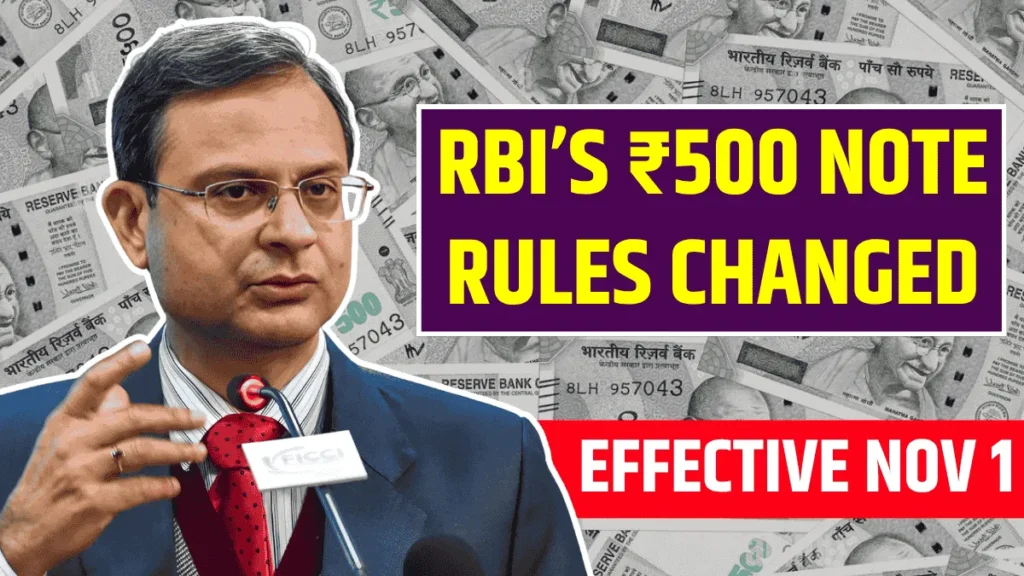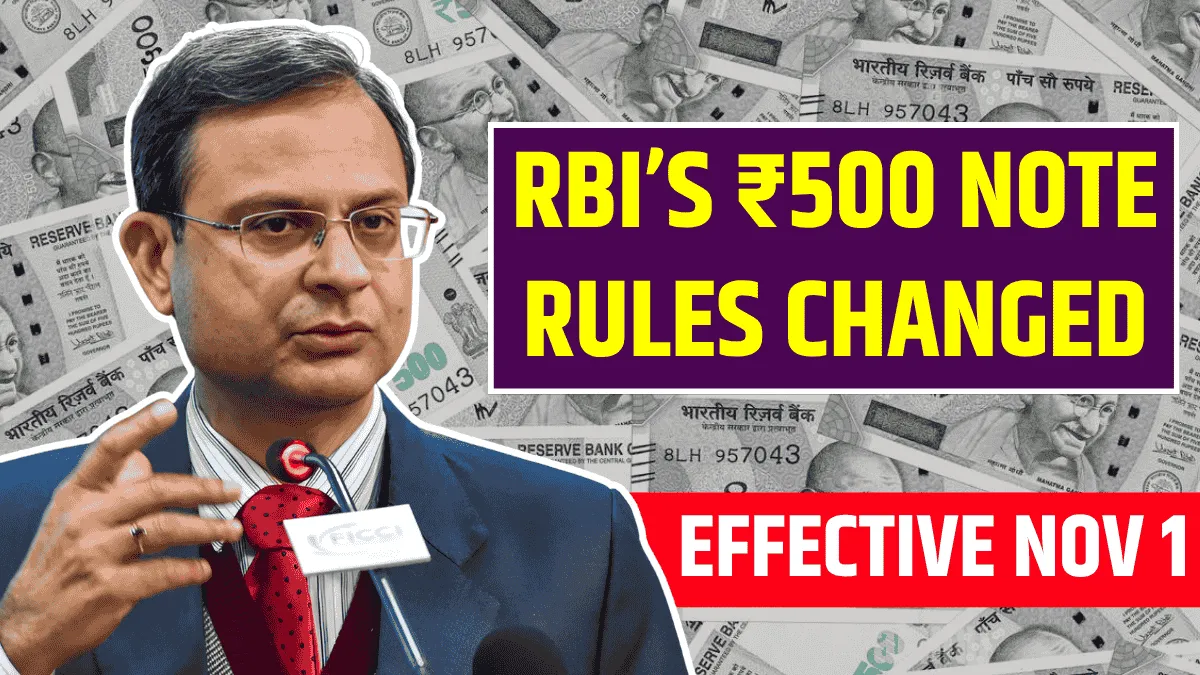There’s growing buzz about changes to the ₹500 note rules tied to new RBI guidelines taking effect on November 1. Any currency update raises obvious questions: Will my cash remain valid, how will banks treat deposits, and do merchants need to change processes? This guide explains what typically shifts when RBI issues currency-related directions, how those changes affect daily life, and how to verify the official position before making decisions. The aim is calm clarity, not panic, and practical steps you can take right away.

What Changed And When
When RBI timelines mention a date like November 1, the change usually falls into a few buckets. Sometimes it’s about fitness standards for soiled or damaged notes and how banks should sort, accept, or exchange them. Other times, it touches on cash handling, counterfeit detection, ATM calibration, or reporting and compliance expectations for banks and businesses. Unless a circular expressly withdraws legal tender status, a note continues to be valid for everyday payments. Always read the exact circular language before drawing conclusions.
What Still Remains Unchanged
In most currency updates, everyday acceptance remains the same unless RBI explicitly states that a note is no longer legal tender or sets a withdrawal window. Design tweaks, security-feature clarifications, and clean note policies do not automatically invalidate notes in your wallet. India’s currency management framework prefers steady, orderly transitions with clear windows and procedures. Absent a direct instruction to stop accepting a denomination, your ₹500 notes remain usable at shops, for bill payments, and for deposits at banks, subject to standard verification.
Impact On Everyday Cash
For most people, daily routines should remain smooth. Buying groceries, paying for services, settling small bills, or using cash for local travel typically continues without disruption. The main difference you may notice, if any, is slightly more careful inspection by cashiers or tellers, particularly if guidelines emphasize counterfeit detection or note fitness. Keep your notes crisp where possible, avoid folding across the security thread, and don’t worry if a shopkeeper briefly checks watermarks or the security thread before completing the transaction.
Banking And ATM Operations
Banks follow RBI sorting, authentication, and reporting norms, and ATMs are calibrated to dispense verified stock. If a guideline affects how notes are sorted, recirculated, or retired from circulation due to wear, you might see ATMs briefly replenished more slowly or branches emphasizing deposit verification. This isn’t a reflection on you; it’s routine compliance. High-value cash activity may draw standard KYC/AML checks, which is normal. Keep ID handy if asked, and retain deposit receipts or acknowledgments to document your transactions.
For Merchants And SMEs
If you operate a storefront or accept cash, focus on training staff to check essential security features and to follow clean note practices. Most updates translate into simple counter checks, prudent cash drawer sorting, and timely deposits. Point-of-sale teams should know what a genuine ₹500 looks like, when to politely decline a badly damaged note, and how to guide customers to their bank for exchanges. Good documentation, clear return policies, and closing-day reconciliations will keep operations smooth even if scrutiny temporarily increases.
Checking ₹500 Note Authenticity
Knowing the genuine features helps everyone. The current ₹500 in the Mahatma Gandhi New Series is stone grey with the Red Fort motif on the reverse and a portrait of Mahatma Gandhi on the front. You should see a watermark of Gandhi and an electrotype 500, a windowed security thread that shifts from green to blue when tilted with RBI and Bharat inscriptions, and a see-through register forming the numeral 500. Raised printing on key elements aids the visually impaired. Denomination numerals appear in Devanagari, and micro-lettering around the portrait helps confirm authenticity.
Handling Old Or Damaged
RBI’s clean note policy encourages exchange of soiled or mutilated currency at banks. A note with normal wear is usually fine for use, while a severely torn, charred, or missing-portion note may be assessed under the exchange rules at designated branches. Scribbles or stamps typically do not by themselves void a note’s value, though excessive defacement may lead a teller to direct you to an exchange counter. If you receive an unfit note, deposit or exchange it promptly rather than recirculating it.
NRIs And Travelers Guidance
If you’re traveling or returning from abroad, treat Indian currency with extra care and follow FEMA rules on possession and carriage. Many travelers lean on digital payments to minimize cash handling, then withdraw modest amounts at ATMs upon arrival in India. If your trip straddles a policy date like November 1, consider keeping bank statements and ATM slips organized, and avoid holding large volumes of cash for long periods. When in doubt, ask your bank for a written clarification tailored to your situation.
Avoiding Rumors And Scams
Currency rumors spread fast, especially near key dates. Be cautious about viral messages that claim overnight invalidation, special exchange fees, or private “conversion services.” RBI announcements are public and straightforward, and your bank will communicate material changes through official channels. Do not hand cash to strangers promising immediate swaps or “upgrades.” If a merchant posts a sign refusing genuine legal tender without cause, you can request the written RBI circular they are relying on or choose another counter.
How To Prepare Today
You don’t need to overhaul your finances. Keep using your ₹500 notes normally, maintain digital payment options as a backup, and deposit excess cash in your account rather than storing it at home. Merchants can refresh staff training on quick authenticity checks and ensure tills are stocked with small change to reduce disputes. Individuals can space out large cash tasks before or after a policy date to avoid queues. Simple organization receipts, statements, and ID goes a long way if banks experience a brief surge.
Verify Official RBI Notices
Because policies evolve, confirm specifics directly with official RBI press releases, FAQs, or your bank’s communication before making major decisions. If you’ve seen a reference to a November 1 circular, note its number and date, then read the exact text to understand whether it affects legal tender status, deposit handling, ATM operations, or only note fitness and sorting. If you cannot locate an official notice, treat social media claims cautiously and ask your branch manager for a written explanation.
Final Word And Next Steps
Currency frameworks are designed for stability. Most RBI updates fine-tune handling, sorting, and authentication rather than abruptly disrupting daily life. Unless a circular clearly withdraws legal tender status, your ₹500 notes continue to function as normal in shops, for deposits, and at ATMs. Stay alert but not alarmed, keep your documentation tidy, and use digital payments as a convenient complement. If a confirmed November 1 guideline applies to you, absorb the details, follow your bank’s guidance, and carry on with confidence.
Disclaimer
This article is provided for general information and educational purposes only. It is not legal, financial, tax, or investment advice, and it should not be relied upon as a substitute for official guidance from the Reserve Bank of India, your bank, or qualified professionals.
Policies, circulars, and operational practices can change without notice. While efforts are made to ensure accuracy at the time of publication, no representation or warranty is given regarding completeness, timeliness, or accuracy. Readers should independently verify details with official RBI publications and their banking institution before making decisions or taking action.
